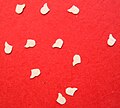
A ticket punch (or control nippers) is a hand tool for permanently marking admission tickets and similar items of paper or card stock. It makes a perforation and a corresponding chad. A ticket punch resembles a hole punch, differing in that the ticket punch has a longer jaw (or "reach") and the option of having a distinctive die shape. A ticket punch resembles a needle punch in that it makes a distinctive pattern in the item punched, but differs in that it makes a chad.



